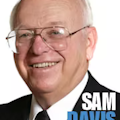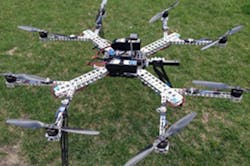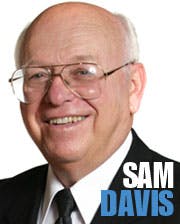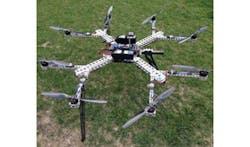HorseFly 'Octocopter' Primed to Fly the Future to Your Front Door
The novel, reconfigurable design of the HorseFly UAV is a product of this research, says Kelly Cohen, an associate professor of aerospace engineering and engineering mechanics. Cohen's team is led by his PhD student Wei Wei with support from fellow students Bryan Brown, Nicholas Schwartz, Vince DeChellis and Nathaniel Richards.
"With the HorseFly project, we developed a brand-new aircraft and airframe from scratch, and we built the system with the ability to look into different applications. Now we can build a family of octorotors and find out the best possible configuration," Cohen says. "There is no textbook on multirotor aircraft design. Here we have been pioneering this effort, and we've come up with something successful."
Key to that success and a primary reason AMP teamed with UC has been the researchers' ability to make the HorseFly safe and resilient. In addition to the sophisticated autonomous controller system, the HorseFly will have multiple built-in hardware redundancies (rotors, onboard computers, battery packs). So if, for example, multiple rotors were to fail, the HorseFly and its payload still could be retrieved safely.
"An important part of the HorseFly project is that we make a vehicle that will not drop out of the sky," Burns says. "This is the particular point that UC specializes in and where we are relying on their expertise to help us build such a safe and resilient craft."
Burns also noted that the HorseFly can be supported by human pilots in a flight control center who can access the aircraft's cameras to choose the safest landing spot.
The partnership between UC and AMP was secured through UCRI, an independent nonprofit entity connecting UC experts to industry partners, facilitating commercialization of research and enhancing experiential learning for UC students.
For HorseFly, Burns connected with Orkwis to explain his vision for the project. Then an agreement was developed in a matter of days with help from UCRI CEO David Linger.
“UCRI supports businesses, small or large, that want to access and leverage the university’s expertise: faculty, students and labs to collaborate with the firm’s researchers,” Linger explains. “The partnership with AMP is a great example of how UCRI can facilitate the path to innovation between private industry and university resources.”
According to Linger, partnerships between the university and private businesses have traditionally been limited to the co-op program or privately-funded research, and were often complicated and time-intensive to undertake. But because it is an independent, small nonprofit, UCRI can leverage the full expertise of the university while executing with agility and efficiency.
Cohen said working with UCRI has opened new doors for his department.
"AMP came up with a vision, and we made suggestions. Those suggestions were translated into a very quick project, something that would have been impossible without UCRI," Cohen says. "Now, we have the possibility of becoming strategic business partners working with industry, pushing the envelope together as we transition technology as well as business ideas due to our knowledge of the market."
Terms of the agreement called for AMP to receive a working, flight-tested design prototype, and a final report and demonstration. AMP provided funding for minimal overhead costs and tuition support for Wei.
Orkwis credited UCRI for streamlining the process and accommodating student involvement in the project. He says the importance of Wei's role was exemplified at a recent flight demo where Wei piloted the HorseFly for AMP investors – a unique real-world experience that is Cincinnati Smart.
"A lot can be attributed to Wei's own can-do attitude. That's really what it comes down to. If you sit back and say, 'No it can't be done,' then who wants to come and work with you?" Orkwis says.
UC and AMP will continue to develop the HorseFly project in anticipation of new Federal Aviation Administration regulations on commercial use of unmanned aerial vehicles. As of now, limited recreational use of UAVs is permitted in the U.S. but commercial activity is not allowed. New FAA rulings are expected soon and could arrive in 2015.
About the Author

Sam Davis Blog
Editor-In-Chief - Power Electronics
Sam Davis was the editor-in-chief of Power Electronics Technology magazine and website that is now part of Electronic Design. He has 18 years experience in electronic engineering design and management, six years in public relations and 25 years as a trade press editor. He holds a BSEE from Case-Western Reserve University, and did graduate work at the same school and UCLA. Sam was the editor for PCIM, the predecessor to Power Electronics Technology, from 1984 to 2004. His engineering experience includes circuit and system design for Litton Systems, Bunker-Ramo, Rocketdyne, and Clevite Corporation.. Design tasks included analog circuits, display systems, power supplies, underwater ordnance systems, and test systems. He also served as a program manager for a Litton Systems Navy program.
Sam is the author of Computer Data Displays, a book published by Prentice-Hall in the U.S. and Japan in 1969. He is also a recipient of the Jesse Neal Award for trade press editorial excellence, and has one patent for naval ship construction that simplifies electronic system integration.


